
I heartily recommend studying the magnificent effects from his books, which also include excellent material without the memorized deck.

Therefore, all of his tricks are models of analysis, creativity and subtlety. It's bold, but can be a great effect.Īll these effects can also be found in the Max Abrams's wonderful compilation, Annemann: The Life and Times of a tigetid (1992).Īs I have mentioned elsewhere in this book, I regard my admired friend Simon Aronson as the one magician who has contributed the most to memo-rized-deck work since the times of Nikola. 1941, there is a trick named "Card Voice" (based on Jor-dan's " The Sagacious Joker", which uses a "tattle-tale card" to divine three cards that spectators have placed in their pockets without looking at them. 267), based on ideas by Charles Jordan and Arthur Finley, that gave birth to my trick "T.N.T.", described in the present work (p. 1938, there is the excellent effect "The Ultra Find" (p. 67.) The previous three Annemann tricks are also included in Hugard's Encyclopedia of Card Tricks (pp. (Frank Garcia takes the effect a step further in Million Dollar Card Sccrcls 11972]. Yet the magician, without looking through the cards, names the selection.

46 is a fine effect, based on an idea mentioned, according to Annemann, around 1907 by Ellis Stanyon in which a spectator genuinely shuffles the deck before he freely chores and buries a card in it. Successfully employed by the Spanish Mnemonica-expert Ramdn Riob6o "The $1,000 Test Card Location" on p. 28 (which eatures the idea of having a spectator hold the deck to the magician's forehead, permitting the latter toī°tt0m Card) and Sympathetic and Ah"f T P' M (Wh]ch Uses the «*™tion of a cut «»a bit of fishing to determine a card someone cut method is extremely useful and is often and He uses a billet index, the one-ahead principle and an arranged deck. 43), based on two ideas by A1 Baker that produce a written double prediction of two freely selected cards. The fertile mind of Annemann has also tackled the subject in his 1934 booklet S-h-h-h.J It's a Secret (a wonderful one, by the way), in the trick titled The Lady and the Gentleman" (p. 11) shows how one can rapidly set the whole deck into Eight-Kings order. Also in The Book Without a Name, "An Original Set-up Discovery" (p. Both of these Annemann tricks also appear in Encyclopedia of Card Tricks (1939) edited by Hugard, pp. This is a card divination accomplished with a cyclic stack, and can be adapted to a memorized deck. 41, and later in his Book Without a Nome (1931), p. Also see his "One in Fourteen", which originally appeared in the March 1927 issue of The Linking Ring, Vol. 11, a spectator selects a card and draws it on a slate, while the magician, mentally following the drawing, makes an identical one on another slate. In his "A Real Psychic Card Test", described in The Jinx, No.

Online index annemann the jinx professional#
29, is direct and powerful, as is all the material performed by this wonderful professional of close-up magic (who, incidentally, had great faith in the memo-which is the case with so many professional cardmen). His "Card Memory" routine, described in Hugard's Magic Monthly, Vol. ^ ^ See "Estimation Card Stab" and "Name a Card"įrom the section titled "Tricks with a Stacked Deck' in The Close-up Magician (1958), edited by Roben par.


 0 kommentar(er)
0 kommentar(er)
